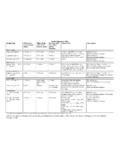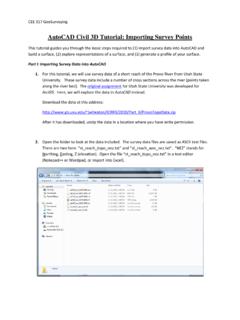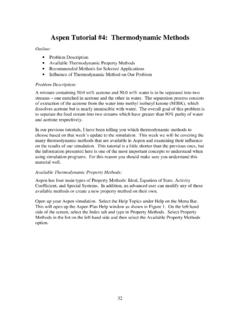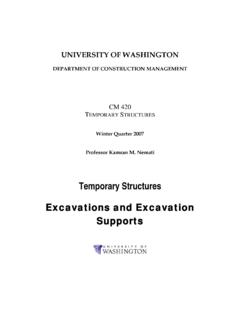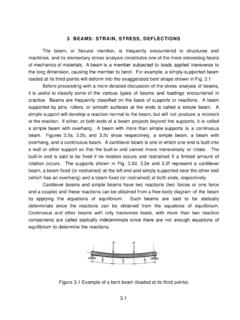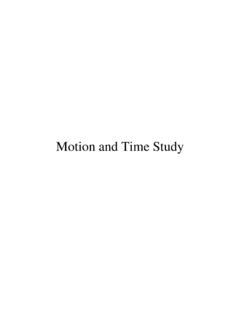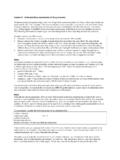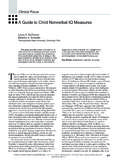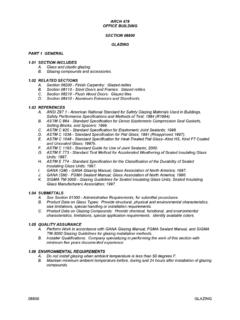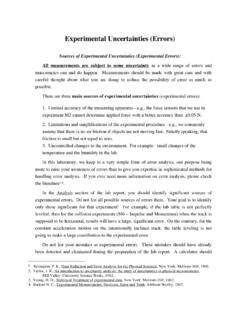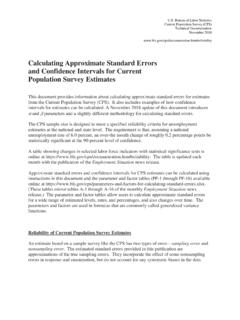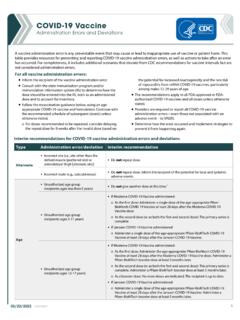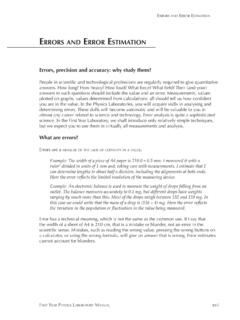Transcription of Propagation of Errors—Basic Rules - University of …
1 Propagation of errors BasicRulesSee Chapter 3 in Taylor,An Introduction toError independent random errors xand y, then the error inz=x+yis z= x2+ independent random errors xand y, then the error inz=x yis zz= ( xx)2+( yy) (x)for some functionf(), then z=|f (x)| will justify rule 1 is easy as soon as we decide on amathematical definition of x, 2 follows from rule 1 by takinglogarithms:z=x ylogz= logx+ logy logz= ( logx)2+ ( logy)2 zz= ( xx)2+( yy)210/5/012where we used logX= XX,the calculus formula for the derivative of 3 is just the definition of derivative ofa Check :To find the volume of a certaincube, you measure its side this uncertainty to a percent and thenfind the volume with its :The volumeVis given in terms ofthe sidesbyV=s3,so the uncertainty in the volume is, by rule 3, V= 3s2 s= ,and the volume Check :If you measurexas100 6,what should you report for x, with itsuncertainty?Solution:Use rule 3 withf(x) = x,f (x) = 1/(2 x), so the uncertainty in xis x2 x=62 10= we would report x= cannot solve this problem by indirectuse of rule 2.
2 You might have thought ofusingx= x x, so xx= 2 x x10/5/015and x= x 2x,which leads to x= 10 The fallacyhere is that the two factors xhave thesameerrors, and the addition in quadraturerule requires that the various errors Check :Suppose you measure threenumbers as follows:x= 200 2, y= 50 2, z= 40 2,where the three uncertainties are independentand random. Use step-by-step propagationto find the quantityq=x/(y z)with :LetD=y z= 10 2 2 = 10 20 20 + 20 Formula for ErrorPropagationWe measurex1, x2.. xnwith uncertainties x1, x2.. xn. The purpose of thesemeasurements is to determineq, which isa function ofx1, .. , xn:q=f(x1, .. , xn).The uncertainty inqis then q= ( q x1 x1)2+..+( q xn xn)210/5/018 Ifq=x1+x2,we recover rule 1: q x1= 1, q x2= 1, q= x21+ x2210/5/019 Ifq=x1 x2,we recover rule 2: q x1=x2, q x2=x1, q= x22 x21+x21 x22= q2[( x1x1)2+( x2x2)2] qq= ( x1x1)2+( x2x2)210/5/0110 Problem Atwood machine consists of two massesMandm(withM > m) attached to theends of a light string that passes over alight, frictionless pulley.
3 When the massesare released, the massMis easily shown toaccelerate down with an accelerationa=gM mM+ thatMandmare measured asM= 100 1andm= 50 1, both in the uncertainty :The partial derivatives are a M=g(M+m) (M m)(M+m)2=2mg(M+m)2, a m=g (M+m) (M m)(M+m)2= 2Mg(M+m)2so we have a=2g(M+m)2 m2 M2+M2 put the numbers in to geta= 50150= a=2 502+ 1002= our answer isa= an object is placed at a distancepfrom alens and an image is formed at a distanceqfrom the lens, the lens s focal length can befound asf=pqp+q.(1)(a) Use the general rule to derive a formulafor the uncertainty fin terms ofp,q, andtheir uncertainties.(b) Starting from (1) directly, you cannotfind fin steps becausepandqbothappear in numerator and , however, thatfcan be rewritten10/5/0114asf=1(1/p) + (1/q).Starting from this form, youcanevaluate fin steps. Do so, and verify that you getthe same answer as in part (a).Solution:(a) The partial derivatives are f p=q(p+q) pq(p+q)2=q2(p+q)2, f q=p(p+q) pq(p+q)2=p2(p+q) f= q4 p2+p4 q2(p+q) (b) The uncertainty in1/pis p/p2, andthe uncertainty in1/qis q/q2.
4 Theuncertainty in1p+1qis ( pp2)2+( qq2)2,which is a relative uncertainty of11p+1q ( pp2)2+( qq2) relative uncertainty inf, as given by(1), is the same, so the absolute uncertainty10/5/0116infis f=f2 ( pp2)2+( qq2)2=1(p+q)2 q4 p2+p4 q2,exactly as in part (a).10/5/0117 Problem that you measure three independentvariables asx= 10 2, y= 7 1, = 40 3 and use these values to computeq=x+ 2x+ycos 4 .(2)What should be your answer forqand itsuncertainty?Solution:Find the partial derivatives, using in radians: q x=x+ycos 4 (x+ 2)(x+ycos 4 )210/5/0118=ycos 4 2(x+ycos 4 )2= q y= (x+ 2) cos 4 (x+ycos 4 )2= q =4(x+ 2)ysin 4 (x+ycos 4 )2= we haveq= q2= ( 2)2+( 1)2+( 3 /180)2= answer isq= SolutionRewrite (2) in the form1q= 1 +ycos 4 2x+ can find the uncertainty in1/q, andtherefore inqby the simple relative uncertainty inycos 4 is 1= ( yy)2+(4 sin 4 cos 4 )2= absolute uncertainty inycos 4 is 2=|ycos 4 | 1= relative uncertainty in1/q 1is 3= ( 2ycos 4 2)2+( xx+ 2)2= absolute uncertainty in1/q 1is 4=|1/q 1| 3= ,which is also the absolute uncertainty in1 relative uncertainty in1/qisq 4,which is also the relative uncertainty the absolute uncertainty inqis q=q2 4=

